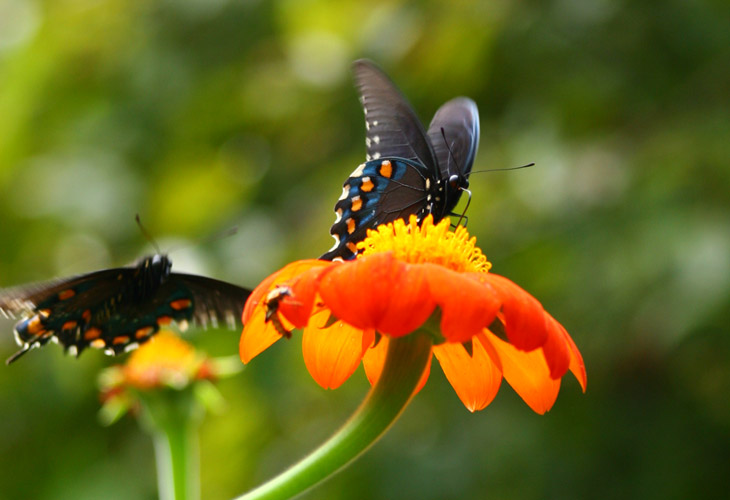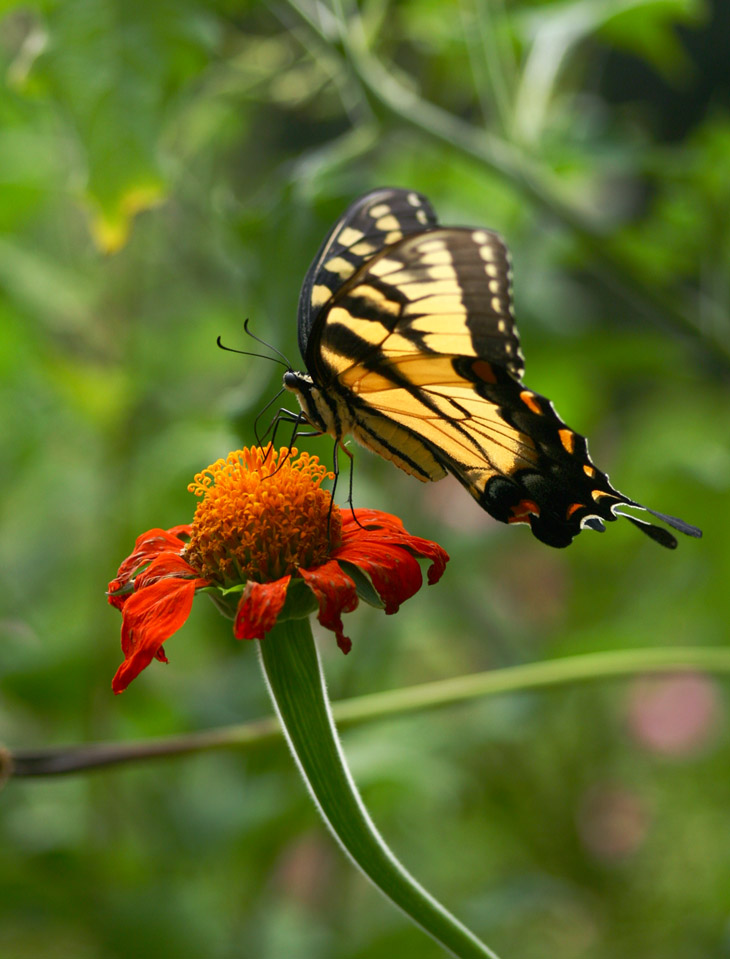
People have the impression that, because they’re pretty and flippy-floppy and all that jazz, butterflies are innocent and carefree creatures, but it takes close observation to see their darker side (as it were.) Judging from the speed and angle of approach, the one on the left was no doubt up to something nefarious when I captured this image, and it was only my presence that thwarted its evil plans. Had there been no observers, who knows what could have transpired?
Seriously, who can tell what happens when no one’s looking? It’s one of those philosophical conundrums. But like so many popular topics, with a complete lack of information it’s okay to speculate wildly and then derive satisfaction from it, so let’s go ahead with the idea that butterflies are obnoxious little shits in reality, and all that dainty stuff that we see is just an act for our benefit. Can you prove that’s not the case? All right, then…
Identifying these individuals from the photo alone could be a little tricky, because there are several species that have almost the same markings. However, the eastern tiger swallowtail (Papilio glaucus) is well-known not only to frequent the area, but to have a dark phase that looks like this. The males however (and some of the females, apparently rival gangmembers,) have a markedly different, yellow color scheme, and these were easy to observe in the immediate area as well, so we’ll consider these all the same species. They were all having a grand ol’ time at my expense in the botanical garden, since I had picked a few good blossoms and shooting angles and waited patiently for any to arrive, but none chose to visit my selected flowers (or indeed any) while I waited. I had not moved very far off after giving up, however, when they appeared and posed, you know, daintily (yeah right) on the flowers, probably waving their antennae in a derisive manner that they hoped I wouldn’t be able to interpret. This happened more than once, so I’m quite certain it was no accident. I told you: little shits…

I was going to let this go at that, but my inquisitive/speculative nature got the best of me, plus I like fostering this in others. So we’ll take a brief look at the subject of the species’ namesake itself, that swallow tail (the two little ‘paddles’ extending from the hindwings,) and wonder what purpose this actually serves. There was a recent study that demonstrated how nearly-identical features on luna moths served to confound the sonar capabilities of bats, which would certainly be good evolutionary survival trait. Except that, swallowtail butterflies are strictly diurnal, while bats are strictly nocturnal, so it seems an unlikely explanation for the feature in swallowtails even though it would work fine for the nocturnal luna moths. But they still may be distantly related. First off, the thing that sparked the appearance of an additional appendage, however small, in that location on the hindwing is almost certainly a genetic mutation from some point in the distant past – it might be prone to appearing in just that location, or it might be the kind of thing that appears at any point along the wings. However, it can’t be something that negatively affects the flight characteristics of the species – either the swallowtails or the luna moths – because that would be selected out, so at the very least we have to assume that it falls in some aerodynamic ‘sweet spot’ that doesn’t induce undesirable drag; while it’s possible that it helps the flight, it seems likely then that a lot of other species would develop the same trait.
Neutral traits can develop, courtesy of a mutation that neither helps nor hinders the species, and thus provides nothing for natural selection to act upon in either direction. These have a tendency to be rare and with little impact, however, because every addition to the development of any individual takes additional energy and resources too, so even the tiny advantage of the ones that did not have it would, over time, cause them to dominate. Which brings us to the other kinds of advantages that these might serve, which are sexual selection and warning displays. The colors of this species serve in both ways, the brighter colors attracting potential mates in a manner that says, “Look how healthy I am!” (which is the same way we distinguish healthy fruits ourselves,) while the sharply contrasting colors serve to be memorable to the predators that tried to eat them and found that they tasted like poop, which is a known defense of most swallowtails and numerous other contrasty species (a few, however, have the coloration to mimic the species that taste like poop, the lazy cheaters.)
Except that, the tails are invariably black, so not showing off either bright colors or warning displays, and about the best that could be said is they’re a kind of ‘conspicuous consumption’ trait similar to peacock tails, demonstrating that the individual is so badass that it can take extra development resources and perhaps even a hit to its flying ability because it isn’t negatively affected by them – kinda like the way drug gangs sport ‘Hello Kitty’ tattoos (they do that, right?) It remains possible that the motion of the tail from an approaching male is highly visible to a female in mating mode, who can judge his, um, ‘worth’ without inquiries over shoe size. If you know what I’m saying.
All of this is mere speculation, since no one’s done a definitive study on those tails yet so, you know, put whatever faith in the suggestions that your desires call for. But keep a watchful eye on the little bastards anyway…




















































